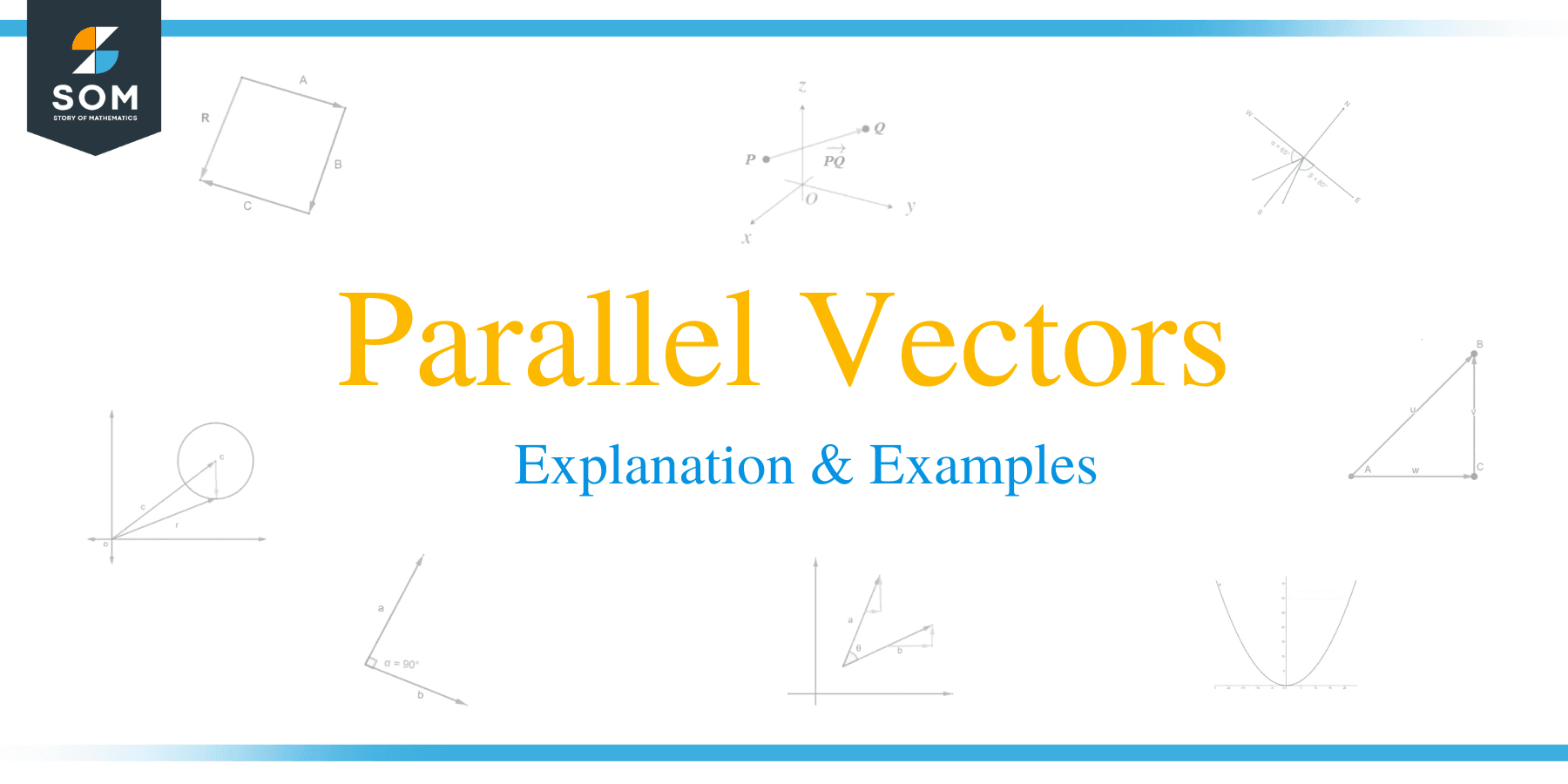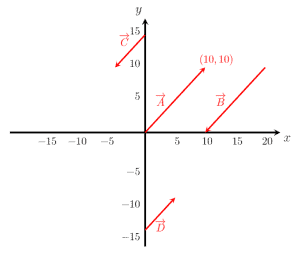- Home
- >
- Parallel Vectors – Explanation and Examples
JUMP TO TOPIC
Parallel Vectors – Explanation and Examples
 Scalar multiplication results in parallel vectors. These are vectors that:
Scalar multiplication results in parallel vectors. These are vectors that:
“Have the same or opposite direction and which are scalar multiples of each other.”
In this topic, we will discuss the following important aspects of parallel vectors:
- What are Parallel Vectors?
- How to Determine if Two Vectors are Parallel.
What are Parallel Vectors?
Usually, two parallel vectors are scalar multiples of each other. Let’s suppose two vectors, a and b, are defined as:
b = c* a
Where c is some scalar real number. In the above equation, the vector b is expressed as a scalar multiple of vector a, and the two vectors are said to be parallel. The sign of scalar c will determine the direction of vector b. If the value of c is positive, c > 0, both vectors will have the same direction. If the value of c is negative, that is, c < 0, the vector b will point in the direction opposite to the vector a.
Similarly, from the above equation, the vector a can be expressed as:
a = 1/c * b
Thus, it is clear that they must be scalar multiples of each other for any two vectors to be parallel. Let’s consider the case when the value of c is zero. Then we can write:
b = 0* a
b = 0
The vector b becomes a zero vector in this case, and the zero vector is considered parallel to every vector.
How to Determine if Two Vectors are Parallel
To determine if two vectors are parallel or not, we check if the given vectors can be expressed as scalar multiples of each other. For example, two vectors U and V are parallel if there exists a real number, t, such that:
U = t* V
This number, t, can be positive, negative, or zero.
Examples
In this section, we will discuss examples related to parallel vectors and their step-by-stop solutions. This will help to build a deeper understanding of parallel vectors.
Example 1
A car is moving with a velocity vector of V1 = 30 m/s North, and another car is moving North with a velocity vector V2 = 60 m/s. Determine whether the two velocity vectors are parallel or not.
Solution
We have the following information:
V1 = 30 m/s, North
V2 = 60 m/s, North
To determine if the given vectors are parallel or not, we check if they can be expressed as multiples of each other or not. We can relate the two vectors as:
V2 = 2 * (30 m/s)
V2 = 2 * V1
V2 = 2 * (30 m/s)
Or,
V1 = 1/2 * V1
V1 = 1/2 * (60 m/s)
V1 = 30 m/s.
Since the given vectors can be related to each other by a scalar factor of 2 or 1/2, we can conclude that the two velocity vectors V1 and V2, are parallel to each other.
Example 2
Given two vectors, S1 = (2, 3) and S2 = (10, 15), determine whether the two vectors are parallel or not. Then, determine the magnitude of the two vectors.
Solution
The given vectors S1 and S2 are expressed in column form. To determine whether they or parallel, we can check if their respective components can be expressed as scalar multiples of each other or not.
S2 = (5*2, 5*3)
S2 = 5* (2, 3)
S2 = 5* S1
Or,
S1 = 1/5* S2
It is obvious from the above equations that the vectors S1 and S2 are scalar multiples of each other, and the scaling factor is 5 or 1/5. Therefore, the given vectors are parallel to each other.
Now, we can compute the magnitude of the given vectors as follows:
|S1| = √2 ^2 + 3^2
|S1| = √4 + 9
|S1| = √13
The magnitude of the vector S2 is:
|S2| = √10 ^2 + 15^2
|S2| = √100 + 225
|S2| = √325
|S2| = √25*13
|S2| = 5*√13
The magnitudes of the two vectors are also related by the scaling factors.
Example 3
Given two vectors, P = (4, 6) and Q = (-2, -3), determine whether the two vectors are parallel or not.
Solution
The given vectors P and Q are expressed in column form. To determine whether they or parallel, we can check if their respective components can be expressed as scalar multiples of each other or not.
P = (4, 6)
Q = (-2, -3)
P = -2 (-2, -3)
P = -2*Q
Since the vector P is -2 times the vector Q, the two vectors are parallel to each other, and the direction of the vector Q is opposite to the direction of the vector P.
Example 4
Refer to the image given below and determine the parallel vectors.

Solution
All the four vectors shown in the image are parallel to each other because they can be expressed as a scalar multiple of the others.
To verify this, express the vectors in their column forms as:
A = (10,10), vector B = (-10, -10), C = (-5, -5) and D = (5, 5)
First, we check if the vectors A and B are parallel or not.
Clearly, vector B can be expressed as:
B = (-10, -10)
B = -1*(10,10)
Or,
B = -1*A
Thus, the vectors A and B are parallel to each other.
Next, we check the vectors C and D as:
D = (5, 5)
C = -1*(5,5)
C = -1* D
Vectors C and D are also scalar multiples of each other.
Similarly, we check the relationships between the remaining vectors:
B = 2* C
B = –2* D
C = –2* A
D = 2* A
Thus, from the above equations and the given image, it is clear that all the four vectors, A, B, C, and D, are parallel to each other.
Example 5
Given that the vectors A = (-4, 6) and B = (x, 12) are parallel vectors, determine the value of x.
Solution
Since the vectors are parallel, we know that:
B = c* A
Where c is some scalar value. Substituting the values of the vectors gives us:
(x, 12) = c* (-4, 6)
(x, 12) = (-4c, 6c)
By setting the individual component values equal to each other, we get:
x = -4c
12 = 6c
Simplifying the above equations gives us:
c = 2
If we put the value of c into the other equation and simplify, we have:
x = -4*2
x = -8
Thus, the vector B becomes:
B = (-8, 12).
Example 6
Given a vector m = 5i + 6j +3 in the orthogonal system, determine a parallel vector to this vector and point in the opposite direction.
Solution
Let’s consider a vector n that is a parallel vector to the given vector m. The vector n can be expressed as:
n = k *m
n = k *(5i + 6j +3)
Where k is a scalar multiple of the vector m. Additionally, k can be positive, negative, or zero. Since it was specified that the given vector must be pointing in the direction opposite the direction of m, k must be non-positive. That is, k < 0. If k = -3 and we get:
n = -3 *(5i + 6j +3)
n = ((-3*5i + (-3*6j) + (-3*3))
n = -15i -18j -9
The resultant vector n is parallel to the given vector and opposite in direction, though there are infinitely many vectors that meet this criterion.
Practice Questions
- Given a vector M = 10 m, East and a second vector, 3M, West. Determine whether the two vectors are parallel or not.
- Given a vector N = 15 m North, determine the resultant vector obtained by multiplying the given vector by -4. Then, check whether the two vectors are parallel to each other or not.
- Let u = (-1, 4) and v = (n, 20) be two parallel vectors. Determine the value of n.
- Let v = (3, 9). Find 1/3v and check whether the two vectors are parallel or not.
- Given a vector b = -3i + 2j +2 in the orthogonal system, find a parallel vector.
- Let a = (1, 2), b = (2, 3), and c = (2,4). Determine whether the given vectors are parallel to each other or not.
Answers
- 3M = 30 m, and the direction is westward. Clearly, the new vector is parallel to the vector M, but its direction is opposite to that of vector M.
- -4N = -60 m. The direction is south. The two vectors are indeed parallel to each other.
- u = k* v, where k = 1/5 and n = -5, v = (-5, 20). The direction of u and v remains the same.
- 1/3v = (1, 3), |v| = 3*√10, |1/3v| = √10. The direction of the vector 1/3v is the same as the direction of vector v, and the two vectors are parallel to each other.
- 5b = -15i + 10j + 10 is one of infinitely many vectors parallel to b.
- The vectors a and c are parallel to each other, but the vector b is not parallel to either of the other two.
